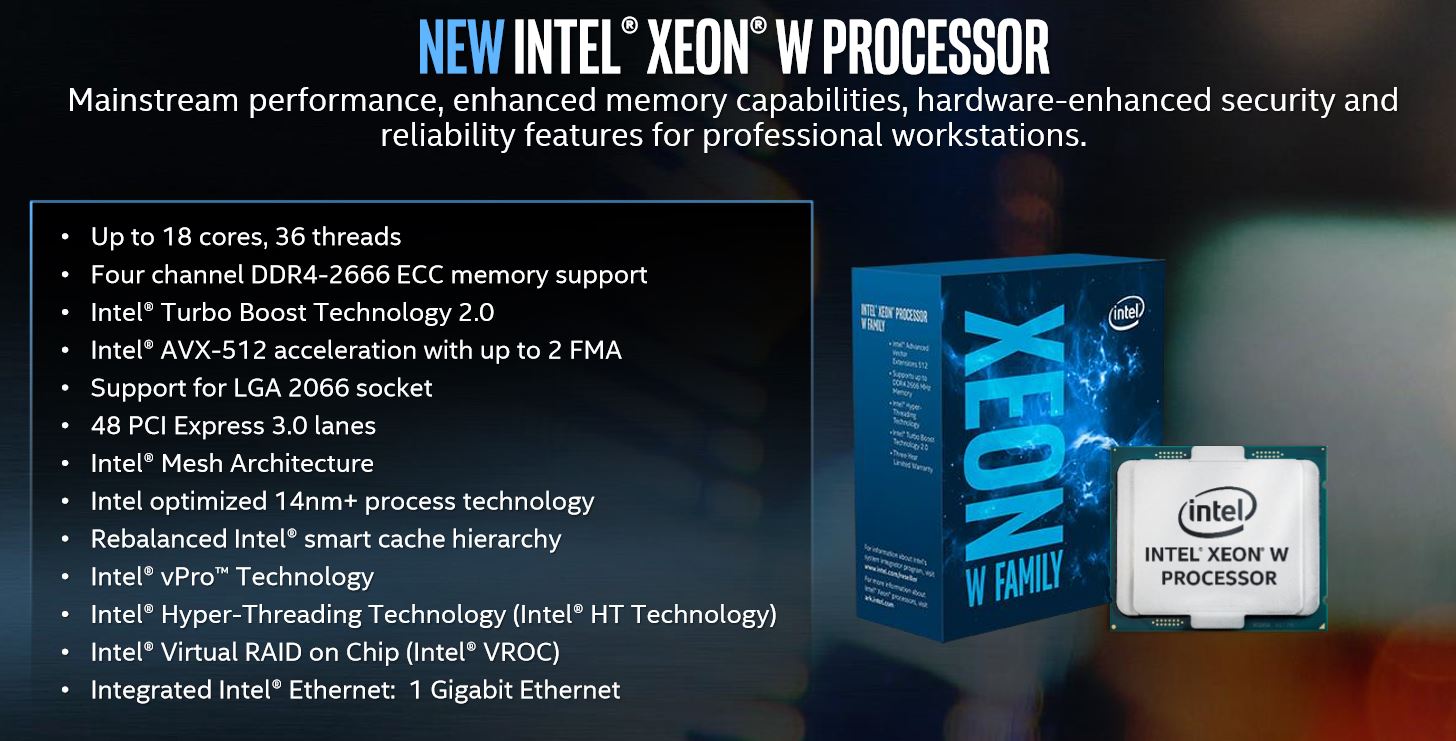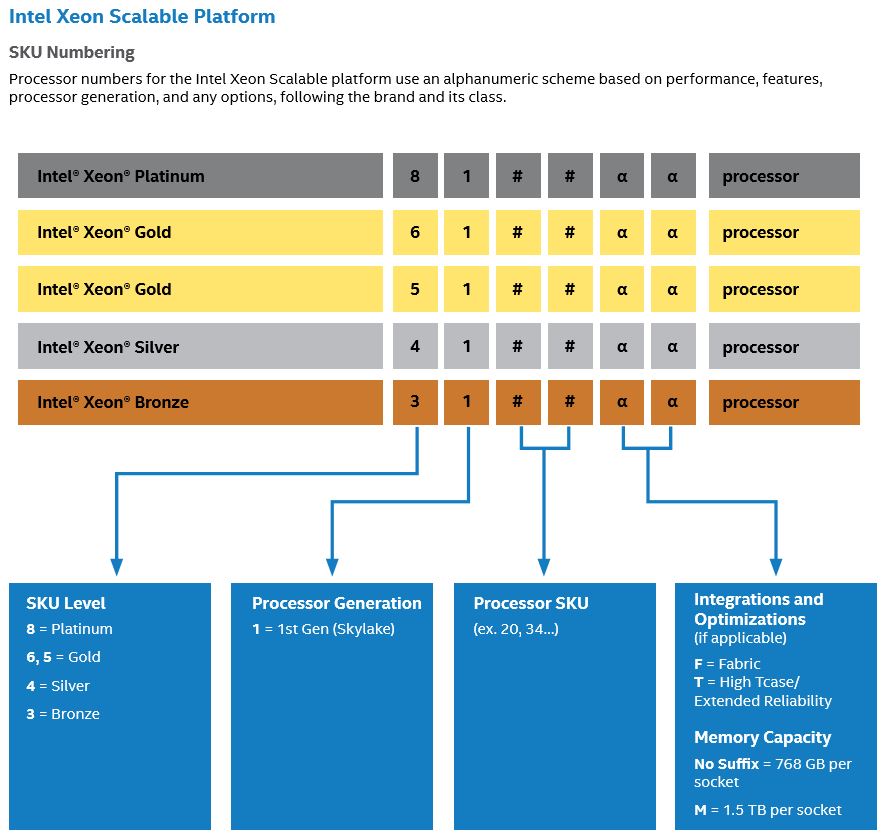Intel Announces Xeon W And Purley Workstation Processors
Intel announced its new workstation processor lineup aimed at professional applications. The company designed the new series to satisfy the needs of traditional workstation-class applications, such as financial trading, computer aided design (CAD), rendering, and 3D and high definition content creation. Intel also named more modern workloads, such as AI analytics and 3D VR content creation, as key focus areas.



Intel split the new series into mainstream and expert workstation classes served by for single- or dual-socket workstations, respectively. Intel's new Xeon W series processors drop into single-socket workstations, while expert workstations feature dual-socket workstations paired with Intel's existing Xeon Scalable Platform (Purley) processors. As with any workstation-focused product, Intel focused on adding manageability, reliability, and security features along with hefty core counts, but some of the processors also feature higher clock frequencies that are well suited to the growing use of GPU-accelerated applications.
The Xeon W series features Turbo Boost frequencies up to 4.5GHz and up to 18 hyperthreaded cores. Intel provided performance comparisons relative to processors from four years ago and claimed up to a 1.87x performance improvement using in the SPECint*_rate_base2006 workload. The company also claims up to a 1.38x improvement over the previous generation processors.
The expert workstation class brings Purley to bear for more intense workloads. The platform features Turbo Boost frequencies up to 4.2GHz and up to 56C/112T on a single platform. Intel's performance comparisons outline much larger performance deltas over the previous generation processors, with up to 2.71x performance improvement over a four-year-old platform and up to a 1.65x improvement over the previous generation processors (SPECfp*_rate_base2006).



Intel's W processors come bearing the now-familiar mesh architecture, rebalanced cache hierarchy, and 14nm+ process technology, indicating these are Skylake-X derivatives. The Xeon W processors drop into the Socket R4 (LGA 2066) on platforms with a C422 platform controller hub. Each of the models features similar characteristics to existing Skylake-X models, with the L3 cache allotments matching the desktop products.
Notably, Intel scrubbed the 16C/32T and 12C/24T Skylake-X equivalents from the lineup. We also notice adjusted base and Turbo Boost frequencies across the entire family, and the processors only support Turbo Boost (TB) 2.0. Intel's TB 3.0 does not make an appearance.
All the processors come with a full complement of 48 PCIe 3.0 lanes and dual 512-bit FMA units for AVX-512, so Intel isn't culling these features with the workstation derivatives. The processors also support quad-channel DDR4-2666 with two DIMMs per channel (2 DPC) but add ECC support to boost reliability. Intel's vPro technology is also a differentiating feature compared to the desktop models.
Get Tom's Hardware's best news and in-depth reviews, straight to your inbox.
On the surface, the 4C/8T W-2125 and W-2123 may appear to be two different revisions of the Kaby Lake-X i7-7740K, but the dual 512-bit FMAs and 48 PCIe lanes indicate these 120W TDP models are likely Skylake-X derivatives.
The remainder of the lineup features a 140W TDP rating, which is surprising for the W-2195 and W-2175. The 18C/36T and 10C/20T Xeon W models appear to be i9-7820XE and i9-7940X equivalents, but those desktop models come with a 165W TDP. The W-2195 features a lower base frequency that may account for the lowered TDP rating, but Intel hasn't revealed the W-2175's frequency range.



Intel's Xeon Scalable Processors (Purley) replace the Xeon E5 v4's for dual socket workstations. We dissected the Purley lineup in our review, and the same key features, including pricing, remain unchanged. Intel offers both Platinum and Gold models with six channels of DDR4-2666. Intel's data center focused Purley models also include "M" variants that support up to 1.5TB of memory, but the workstation processors only support 768GB. They also don't come with integrated Omni-Path capabilities, which makes sense given the workstation focus. The processors drop into the the LGA-3647 socket on platforms with the C621 Lewisburg chipset.
The family tops out at the $10,009 Platinum 8180 28C/56T processor, which creates a 56C/112T dual-socket workstation. The series dips down to the Platinum 8156 4C/8T model that retails for an eye-watering $7,007. Again, the entire lineup features 48 PCIe lanes and 2 512-bit FMAs for AVX-512 workloads.
Intel has a range of partners, including Dell, Fujitsu, HP, and Lenovo, among others, bringing OEM systems to market. We also expect the normal crush of announcements from motherboard vendors over the coming days. Intel hasn't specified when the Xeon W processors will be available worldwide, but we do know the Purley processors are already on the market.
-

Paul Alcorn is the Editor-in-Chief for Tom's Hardware US. He also writes news and reviews on CPUs, storage, and enterprise hardware.
-
bit_user ReplyNotably, Intel scrubbed the 16C/32T and 12C/24T Skylake-X equivalents from the lineup. We also notice adjusted base and Turbo Boost frequencies across the entire family, and the processors only support Turbo Boost (TB) 2.0. Intel's TB 3.0 does not make an appearance.
So... I guess this is their solution to the dismal thermal situation under that heat spreader. I'm in no hurry, so we'll just see if the next gen has solder.
All the processors come with a full complement of 48 PCIe 3.0 lanes and dual 512-bit FMA units for AVX-512
nice!
-
bit_user BTW, had to LOL at the "Expert Workstation" branding. As if to say "you're a n00b unless you spend at least $1.7k each, on a pair of 6-core CPUs".Reply
But I am glad that Purley workstations will be a "thing", because it means we can buy used server CPUs and probably find a desktop board to put them in. -
Ne0Wolf7 BIT_USER, you already can put sevrer procesors in cosumer boards. I have a Xeon E3-1231 V3 in my ASRock Z97 PRO4.Reply
And I agree, it is funny with the whole "expert" branding. -
bit_user Reply
Yes, and I like that. Even E5-series Xeons, which are their mainstream server line.20117830 said:BIT_USER, you already can put sevrer procesors in cosumer boards. I have a Xeon E3-1231 V3 in my ASRock Z97 PRO4.
But I was worried those day were at an end. I was referring specifically to their new LGA-3647 socket. I had feared they were going to make it a strictly server-only socket. -
GR1M_ZA So still only 48 PCI-E lanes for a $10K processor ? Come on Intel ! ! ! Then AMD Threadripper is still a good buy at $1K for 64 PCI-E lanes if that is what you need. At an AMD vs Intel comparable C/T count the Intel offering is over $2K more expensive !? DAMN.......Reply -
michael.j.j.obrien Wow 10K. I don't think I will. If I could afford it for a desktop I don't think current desktop cooling technology would handle 205W and 20+ cores. I would imagine that all the Xeon cores are locked due to thermal management.Reply
It puzzles me why overclockers ask if these are locked. Usually they are because most are destined to live in rack mounted server arrays. So overclocking individual processors is not a realistic option as yet.
The Skylake X processors and all the other unlocked processors are aimed at Desktop overclockers. I guess the grass always looks greener!
I get why using retired Xeon processors is a good way to go. Where do I get them from? -
dalauder Reply
These articles get into building viable 32-thread and 40-thread systems. The 32-core system seemed more likely to pan out well, IIRC: https://www.techspot.com/review/1155-affordable-dual-xeon-pc/20119264 said:Wow 10K. I don't think I will. If I could afford it for a desktop I don't think current desktop cooling technology would handle 205W and 20+ cores. I would imagine that all the Xeon cores are locked due to thermal management.
It puzzles me why overclockers ask if these are locked. Usually they are because most are destined to live in rack mounted server arrays. So overclocking individual processors is not a realistic option as yet.
The Skylake X processors and all the other unlocked processors are aimed at Desktop overclockers. I guess the grass always looks greener!
I get why using retired Xeon processors is a good way to go. Where do I get them from?
Here's the 40 core: https://www.techspot.com/review/1218-affordable-40-thread-xeon-monster-pc/
Still...with 32-thread Ryzen Threadrippers, the only reason to go with Xeons if if you need ECC memory along with the other precision features.
For jobs like animation, architecture, or structural engineering, you never need that level of precision as either lives don't depend on it or you have conservative factors of safety.

